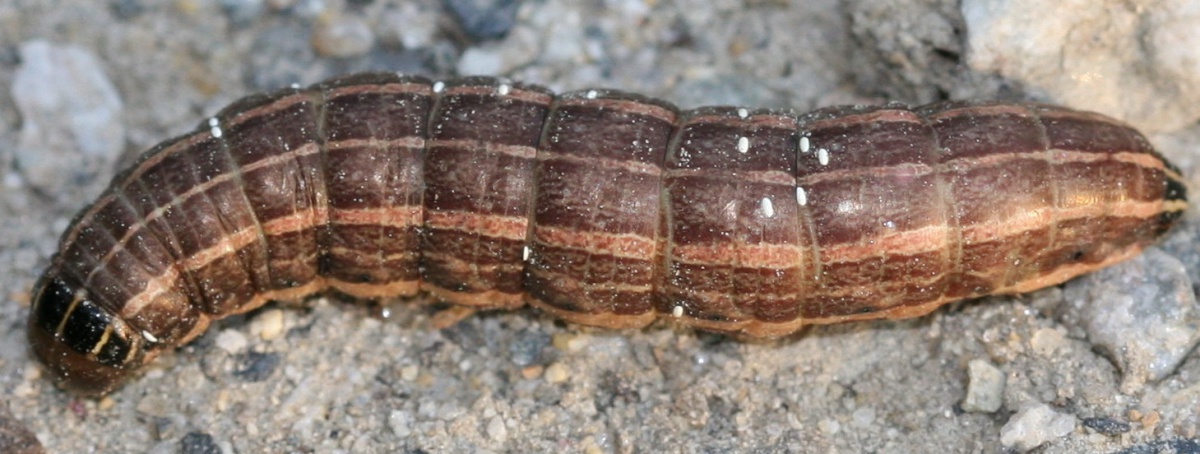Cutworms are the larval form of dozens of different species of small brown or tan, banded moths. Depending on the species, cutworms damage plants in several ways:
- Surface cutworms chew plants just above or just below the soil level, typically eating just enough of the stem to make the plant topple over, but occasionally dragging plants or plant parts down into their burrows.
- Climbing cutworms climb the stems of herbaceous plants, shrubs, vines and trees, feeding on buds, stems, leaves, and fruits.
- Army cutworms occur in great numbers and, after consuming the vegetation in one area, migrate by the thousands onto adjacent land. Army cutworms feed mainly from the tops of plants but, in large enough numbers, will consume entire plants.
- Subterranean cutworms remain in the soil and feed on roots and the underground parts of stems.

Description
The adults of all cutworm species are night-flying moths with wingspans from 1.5 to 3". Only the larvae damage plants; adult moths feed off the nectar of wild and cultivated flowers. Full-grown larvae are 1-2" long, soft, plump, hairless caterpillars whose color and markings vary from dingy white to tan, brown, charcoal gray or black, depending on species. A disturbed cutworm will curl up into a tight ball.
Life Cycle
Most species of cutworms overwinter in the soil or under vegetative debris as partly-grown or full-grown larvae. The larvae begin feeding in early spring and continue growing until early summer, when they pupate in the soil, emerging as moths one to eight weeks later.
Most species lay their eggs on the stems of grasses and weeds, though some lay eggs on bare ground. Depending on the species, the eggs will hatch in a few days to two weeks. Most species of cutworms take shelter in the soil by day and come out to feed at night. Surface cutworms cause the most damage in New Hampshire gardens and landscapes, chewing the stems of newly-emerged seedlings and transplants in early to late spring.
Management
IPM Strategies:
- Monitoring and Cultural Practices - To determine if cutworms are present, look for signs of freshly cut plants. Take a flashlight at night to search the base of the freshly cut plants and the top layer of soil for cutworms. Handpick any cutworms you find and squash them or drown them in a bucket of soapy water.
Since adult female moths lay their eggs in fall, removing weeds and mowing the grass close to the ground will help prevent cutworm infestations.
A protective collar made of plastic, sturdy cardboard, cut-up drink bottles, milk cartons, toilet paper rolls, etc., can protect transplants against cutworms. Place the collar around the plant stem, making sure it extends at least an inch down into the soil and two inches above soil level.
- Chemical Control - Use a cutworm bait and sprinkle around the base of susceptible plants, when they are young (tender). Several pesticides are registered to be sprayed on young plants. Be sure the label lists the species you intend to control and the crop you intend to treat. Consult your county Agricultural Field Specialist for specific recommendations.

when disturbed). Credit: Alan T. Eaton.
Stop! Read the label on every pesticide container each time before using the material. Pesticides must be applied only as directed on the label to be in compliance with the law. All pesticides listed in this publication are contingent upon continued registration. Contact the Division of Pesticide Control at (603) 271-3550 to check registration status. Dispose of empty containers safely, according to New Hampshire regulations.
Download the resource for the complete factsheet.

